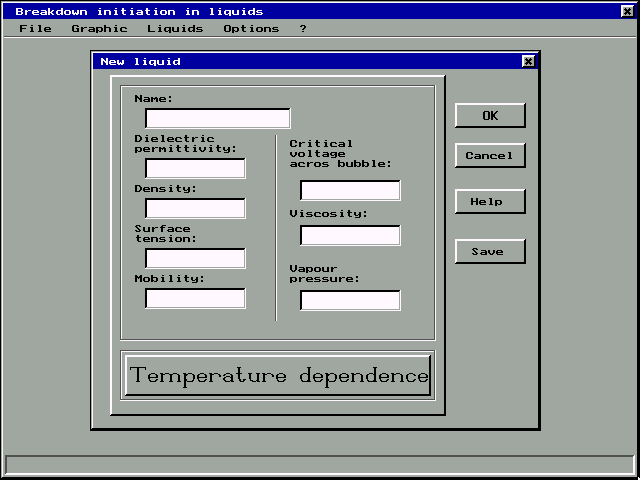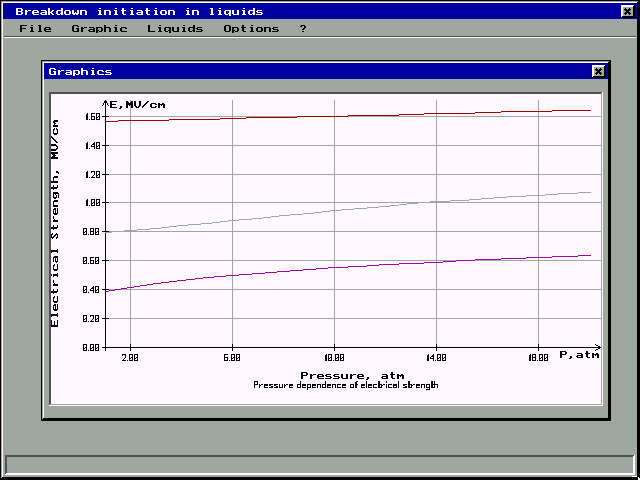
Research and Educational Computer Program of Breakdown Initiation in Liquids
S.M.Korobeynikov, Yu.N.Sinikh and A.G.TregubovNovosibirsk State Technical University
20, K.Marx Avenue., Novosibirsk, 630092
RUSSIA
Computer program лBubbreak╗ is designed with two purposes: educational and research. It consists of three parts: computation of prebreakdown time duration t(E, P, T, r0) according to bubble model of breakdown initiation, graphic simulation of prebreakdown processes in gap with the visualization of bubbles on electrodes, mathematical treatment of
t(E, P, T, r0) to get E(t)╜ P,T,r, E(P)╜ t,T,r, t(E)╜ P,T,r, t(P)╜ E,T,r, E(T)╜ P,E,r, t(r0)╜ P,T,E.
It is assumed that in every
dependency other parameters is fixed, but can be changed with the help of special data
window. Here E - electrical field intensity, P - outer pressure, T -temperature, r0
- radius of most лdangerous bubble╗ that is on electrode. The liquid for treatment can
be chosen from library. For the new dielectric liquid it is necessary to input it’s
physical properties:
dielectric permittivity e , vapor pressure Ps(T),
viscosity h (T), surface tension s .
With the help of dialog windows one can choose required dependency and it’s physical
parameters. Only one model’s parameters critical field strength it should to input.
Default it is 10 MV/cm.
Introduction
The basement of the program is the bubble model of breakdown initiation [1-3]. It is assumed that at the surface of electrodes exist bubbles of micron sizes. There are several reasons of stationary bubbles existence and emergency on electrodes. The partial discharges should occur inside bubbles. Emergence of surface and space charge near bubbles poles due to discharges leads to bubbles deformation due to Coulomb forces. Bubble elongation causes field increase in liquid near bubble poles. Breakdown initiates in liquid phase when this field reaches critical value that depends on the liquid sample and the polarity of initiating electrode. The equation of bubble growth is computed. The basic factors that define electrical strength in model are external factors: the pressure, temperature; properties of liquid: dielectric permittivity, vapour pressure, viscosity, surface tension, density; pulse voltage parameters: the rate of pulse rise, pulse width; properties of liquid-electrode interface that determine charge injection. This performs to compute the well-known breakdown dependencies.
Structure of the program.
The program лBubbreak╗ (лBreakdown Initiation in liquids╗) is prepared by using the programming language Pascal in the systems Borland Pascal or Borland Delphi. The start of the Pascal program is usual for operation system MS-DOS and is carried out by a input лBB╗ in a command line. The start of the program from лWindows╗ by a usual way is possible.
For work of the program the following files are required: EGAVGA.BGI and SVGA256.BGI - files of graphic drivers; MAT.DAT - data on liquids; MOD.TXT - description of model of breakdown; ┬┬.EXE - executed module.
The files that created are OPTIONS.BB - configuration file; BB.DAT - list of all users; ST*.DAT - results of studies of the users; ST*.PCX - diagrams; ST*.TXT - parameters to the diagrams.
Program consists of the following blocks:
a) Computation of prebreakdown time in case of discharge initiation at the anode or at the cathode. It depends on pressure, intensity of a field, temperature, size bubble t(E, P, T, r0). This is performed by the numerical decision of the ordinary differential equation of the second order. The method of Runge-Cutt-Merson of the 4-th order is chosen. The advantage of this method in comparison with a usual method Runge-Cutt consists in less time of computations. It is reached due to a variable step on time. The choice of a step amount is made after an estimation of an error at every step.
b) Dependence t (E,P,T,r0) transforms with the purpose of reception of
the necessary dependence
E(t)╜ P,T,r, E(P)╜ t,T,r,
t(E)╜ P,T,r, t(P)╜ E,T,r,
E(T)╜ P,E,r, t(r0)╜
P,T,E..
Besides, here are radius and velocity
dependencies on time. In each of dependencies other parameters are considered fixed, but
their value can be changed in the subsequent accounts;
c) Construction of the diagrams in logarithmic or linear scale;
d) Data input (choice of a liquid from library, change of parameters of account and display), choice of required dependence, and also input of a new liquid;
e) Information on the breakdown theory, instruction on work with the program and authors’ information;
f) Work with the user (student, or researcher) supposing registration, save, viewing and removal of the initial and received data.
Brief description.
For work beginning, it is necessary to be registered, by choosing submenu лRegistration╗ of the menu лFile╗. In the appeared dialogue window лRegistration╗ it is necessary to enter the name. At absence of registration the data will not be saved.
Choice of dependence, which diagram you want to receive, is carried out by selection submenu лParameters╗ which are taking place in the menu лGraphic╗ (fig.1).
For each chosen dependence some other parameters are assumed лconstant╗ parameters. By default are established:
╖ Pressure P - 1 atm;
╖ Electrical field intensity E - 1 ╠┬/ёь;
╖ Duration of a pulse width t - 1 m s;
╖ Temperature T - 20░ ╤;
╖ Factor describing the relation of radius of investigated bubble to radius of лmost dangerous╗ bubble, - 1,
Usually E or t is function, one from another parameters is argument on diagram, лconstant╗ will be 3 parameters. These parameters for the given dependence are independent and can be changed in the appropriate fields of input. For example, for dependence E (P) constant will be t, T and r0.
If select лElectrodes╗ it is possible to set the form of an electrode, from which occurs breakdown (plane, edge, sphere), polarity of an initiating electrode (anode or cathode) and critical field intensity ┼m. (In the present moment from the forms of an electrode the plane is realized only.) If select лPulse╗ one could select the form of pulse of voltage (fig.2a).
The computation and plot of graphs is reached at a choice of лPlot╗ of the menu лGraphic╗.
For saving of the received data it is selected лSave╗, taking place in a submenu лGraphic╗. The names of a file, in which save the plot and parameters of account, are defined automatically and have expansion Ёёї and dat accordingly. If before saving of plot the registration was not taken place, the message on a mistake will be given.
In the program there are three optional parameters for a graph plotting, to establish which the submenu лGraphic╗:
р) л All plots ╗;
At installation of this parameter on the screen will be presented no more last 5 plots differing only on one of the following parameters:
╖ The name of a liquid;
╖ Time breakdown;
╖ Field intensity;
╖ Pressure;
╖ Temperature;
╖ Initial radius of bubble.
╖ Thus a choice of differing parameter the program carries out automatically. If the option л the Signature to the diagrams ╗ is established, under the diagram the signature will be formed.
╖ If this option is not established, on the screen last computed dependence will be shown only;
╖ с) л A framework around of the diagram ╗;
╖ At installation of this parameter the diagram will be led round by a framework on perimeter;
╖ т) л The explanation to the diagram ╗;
╖ If this flag is established, the diagram will be accompanied by heading, which is formed automatically. Depending on an option л All plots ╗ the explanation can be various.
For a choice of a liquid, it should to select лChoice╗ in the menu of лLiquid╗.
The data for n-hexane, glycerol, water and transformer oil are in library (by default is
established n-hexane). If it is necessary to add in library of liquids one more dielectric
liquid, the submenu of лLiquid╗ is necessary to select лNew╗. Dialogue window л
Creation of a new liquid ╗ (fig.2b) requires input its parameters (name, dielectric
permittivity, density, viscosity for temperature 20░ ╤.
For account of temperature dependence it is necessary
to set Ps(T) and h (T)
The лHelp╗, лBubble Theory╗ and лAuthors╗ are created in the point of the menu л?╗.
For an illustration of model of discharge initiation in liquids the demonstration of prebreakdown processes was specially developed. At a choice of лDemo╗ in submenu лFile╗ on the screen there is a window of demonstration, in which it is possible to see interelectrode gap and bubbles that located on the electrodes surface (fig.2c). There are bubbles of three colors. It is лmost dangerous╗ bubble of yellow color and two bubble of red and white color, which sizes accordingly are more and less size than лmost dangerous╗ bubble. The process of breakdown initiation occurs as follows. After voltage action the growth of bubbles begins. Thus bubbles, having radius it is less than лmost dangerous╗, do not grow in general, since in them do not occur processes of impact ionization. As soon as лmost dangerous╗ bubble will reach the size, sufficient for the initiation of breakdown in the liquid phase, modeling process of growth of breakdown tree begins. It is based on the model of the лcell automatic device╗. In process of breakdown tree growth bubbles of red color continue to grow, though do not reach the deformation that is necessary for the beginning of discharge initiation from them.
The velocity of breakdown in лDemo╗ can be operated: by pressing a key л Gray - ╗ the delay time before the next addition of лbranch╗ of a breakdown tree decreases, i.e. the mean breakdown velocity is increased, and by pressing on л Gray + ╗ the time of a delay is increased, breakdown velocity thus decreases. The breakdown occurs when one branch of tree touch the opposite electrode.
The test of breakdown can be repeated by pressing on a key лBlank╗, thus the initial (but another) arrangement of bubbles will be placed on electrodes surfaces. The exit from the лDemo╗ is carried out by pressing a key л Esc ╗.
The exit from the program is carried out by usual way.

Fig.1. The main breakdown dependencies
The examples of computation of breakdown depend-encies are presented in [2,3]. On fig.2.d it is showncomputed pressure dependencies of electrical strength at varying pulse duration. One can see well known experimental evidence: less pulse duration - less pressure dependence.
The described version of the program is not final. Now the bubble statistics is inserting in program. The next version will be prepared with the help of лBorland Delphi╗.
Conclusion
Computer program лBubbreak╗ is based on bubble model of breakdown initiation. The physical basement performs to compute and show the most of breakdown dependencies.
Literature.
1. Korobeynikov S.M. Yanshin E.V. Bubble Model: Time Dependent Pressure Effect. Conf.Record of the 10-th International Conference on Conduction and Breakdown in Dielectric Liquids, 1990, Grenoble, France, pp. 360-364.
2. Korobeynikov S.M., Sinikh Yu.N. Bubbles and Breakdown of Liquid Dielectrics. Conference Record of the 1998 IEEE International Symposium on Electrical Insulation. Arlington, Virginia, USA, pp. 603-606.
3. Korobeynikov S.M. The Role of Bubbles in the Electric Breakdown of Liquids: Comparison with Experiment. High Temperature. Vol.36, No.4, 1998, pp.517-523.



c)
Demo of breakdown tree
Fig.2.